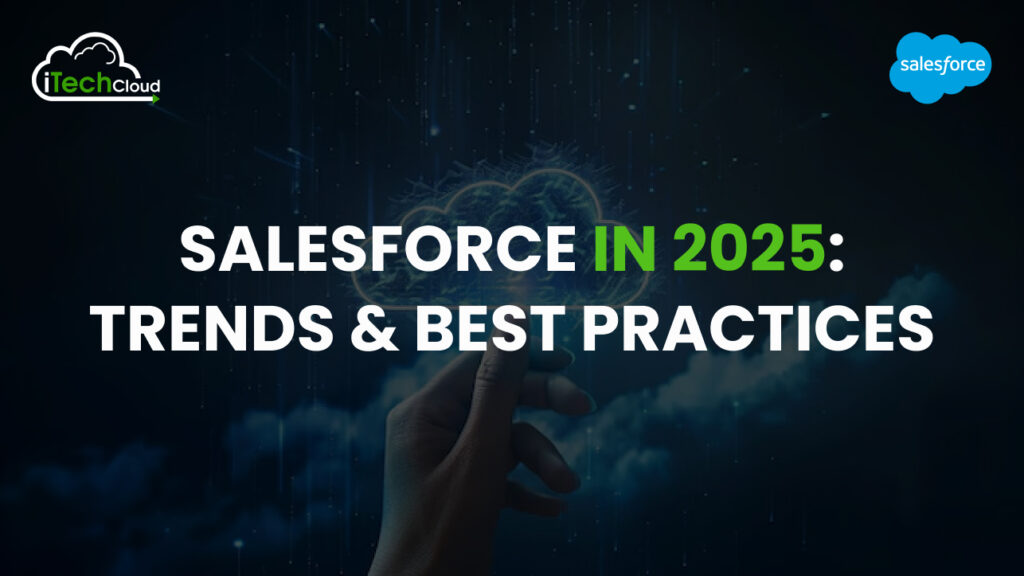Salesforce in 2025: Trends & Best Practices

Salesforce continues to be at the forefront of customer relationship management (CRM) solutions, offering cutting-edge tools that empower businesses to engage with customers more effectively. As we move into 2025, several trends and best practices are shaping how organizations utilize Salesforce to drive success. This comprehensive guide outlines these developments in detail and offers actionable insights to make the most of Salesforce in the year ahead.
Table of Contents
1. Introduction to Salesforce in 2025
Salesforce has grown from a CRM tool into a comprehensive ecosystem that caters to diverse business needs, from sales and marketing to analytics and sustainability. In 2025, businesses must adapt to new trends to maximize Salesforce’s potential in a competitive and rapidly evolving landscape.
2. Key Trends for Salesforce in 2025
1. AI-Powered CRM (Salesforce Einstein)
- Salesforce Einstein is becoming integral to delivering personalized, AI-driven customer experiences.
- Capabilities:
- Predictive analytics for sales forecasting.
- Automated sentiment analysis to gauge customer satisfaction.
- Intelligent chatbots for 24/7 customer support.
2. Increased Adoption of Industry Clouds
- Salesforce Industry Clouds provide sector-specific solutions, such as Financial Services Cloud and Health Cloud.
- Benefits:
- Custom workflows tailored to industry requirements.
- Built-in compliance features to meet regulatory standards.
3. Focus on Hyper-Personalization
- Businesses are leveraging customer data to create real-time, tailored interactions.
- Tools like Customer 360 enable a unified view of customer interactions across channels.
4. Sustainability and ESG Integration
- With growing emphasis on environmental, social, and governance (ESG) goals, Salesforce’s Net Zero Cloud is gaining traction.
- Organizations are using this tool to monitor carbon footprints and develop sustainable business strategies.
5. Integration with Emerging Technologies
- Collaboration with IoT, blockchain, and extended reality (AR/VR) is becoming mainstream.
- Salesforce’s API capabilities facilitate seamless integration of these technologies to expand functionality.
6. Low-Code/No-Code Development
- Tools like Salesforce Flow are empowering non-developers to build custom applications and automate workflows.
- Impact:
- Faster time-to-market for applications.
- Reduced dependency on IT teams.
7. Data Privacy and Compliance
- With stricter global data regulations like GDPR and CCPA, Salesforce’s compliance tools are critical.
- Features such as Shield ensure data encryption and secure access controls.
8. Focus on Mobile-First CRM
- The shift toward mobile-first strategies ensures Salesforce is optimized for on-the-go users.
- Mobile apps offer real-time data access, enabling sales teams to stay productive anywhere.
3. Best Practices for Salesforce in 2025
1. Invest in Training and Certifications
- Stay updated with Salesforce innovations by:
- Utilizing Trailhead for continuous learning.
- Encouraging team members to earn certifications like Salesforce Administrator and Salesforce Developer.
2. Optimize the Salesforce Ecosystem
- Conduct regular audits of your Salesforce instance to identify and remove redundancies.
- Integrate third-party apps to enhance functionality and streamline workflows.
3. Prioritize Customer-Centric Strategies
- Leverage tools like Customer 360 to create a unified view of customers.
- Focus on real-time customer engagement to build loyalty.
4. Adopt Agile Methodologies
- Implement agile practices to ensure iterative development and faster deployment of Salesforce solutions.
- Use feedback loops to improve user experience continuously.
5. Harness Automation
- Automate repetitive tasks using Salesforce Flow and AI-driven workflows.
- Use tools like Einstein Automate to simplify complex processes.
6. Regularly Update and Upgrade
- Take advantage of Salesforce’s seasonal releases to access new features.
- Plan for timely upgrades to stay ahead of competitors.
7. Focus on Security
- Implement robust security practices, including:
- Multi-Factor Authentication (MFA).
- Role-based access controls.
- Regular security audits to identify vulnerabilities.
4. Success Stories and Case Studies: Salesforce in 2025
Businesses across industries are leveraging Salesforce to achieve remarkable results. For example:
1. Retail
- A leading retailer used Salesforce Marketing Cloud to drive personalized email campaigns, resulting in a 30% increase in customer retention.
2. Healthcare
- A hospital implemented Salesforce Health Cloud to streamline patient management, reducing appointment scheduling time by 40%.
3. Financial Services
- A bank adopted Financial Services Cloud to provide tailored financial advice, boosting client satisfaction by 25%.
5. Future Outlook: Salesforce in 2025
1. Salesforce’s Role in Digital Transformation
- Salesforce remains a cornerstone for achieving operational efficiency and enhancing customer experience.
2. Preparing for 2026 and Beyond
- Anticipate the introduction of new tools and features, such as enhanced AI capabilities and expanded industry-specific solutions.
- Align long-term strategies with Salesforce’s evolving roadmap to maintain a competitive edge.
6. Conclusion
Salesforce in 2025 offers unparalleled opportunities for businesses to excel in customer relationship management. By staying updated with the latest trends, leveraging best practices, and adopting a forward-looking approach, organizations can maximize their investment in Salesforce and drive growth in an increasingly digital world. Now is the time to explore, innovate, and lead with Salesforce.

